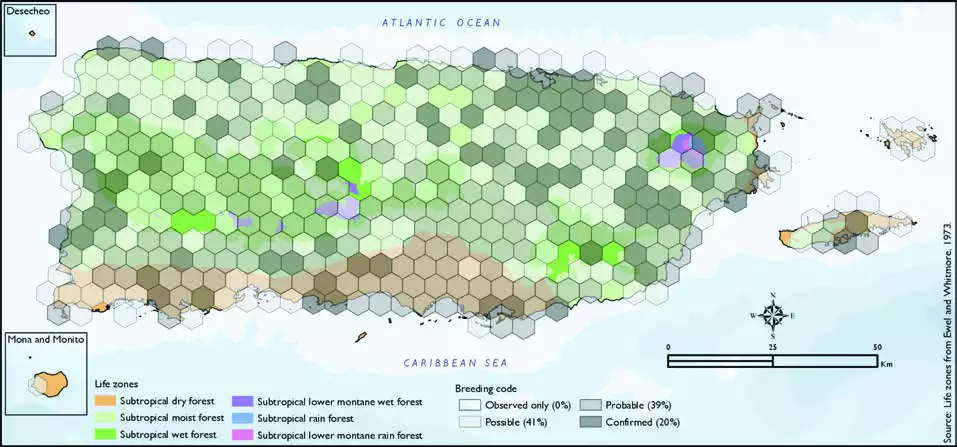White-winged Dove
Description
The white-winged dove (Zenaida asiatica) is a dove whose native range extends from the Southwestern United States through Mexico, Central America, and the Caribbean. They are large for doves, and can be distinguished from similar doves by the distinctive white edge on their wings. They have a blue eyering, and red eyes. The plumage is brownish-gray to gray. Juveniles are duller in color, and have brown eyes. The call is likened to English phrase "who cooks for you". There are three subspecies. It was first described by George Edwards in 1743, and given its binomial name by Linnaeus in 1756. It was moved into the genus Zenaida in 1838.
Distribution & Habitat
The White-winged Dove occurs through southern North
America, Central America, and
western South America (Bond
1961, Raffaele and others 1998).
In the West Indies, it can be
found in The Bahamas, Cuba,
Jamaica, Hispaniola, the Cayman
Islands, San Andrés, Providencia,
Puerto Rico, St. Croix, St. John
(Raffaele and others 1998), and
St. Thomas. The species was first
recorded on Puerto Rico in 1943
(Raffaele 1989a) and has since
expanded its range throughout
the island. It first occurred on
Vieques in 1971 (Sorrié 1975)
where it is now an abundant breeding resident (Gemmill
2015). This species occurs
mostly in gardens, agricultural
areas, mangroves, dry scrub
forest (Oberle 2018), and open
woodlands (Raffaele and others
1998, Saliva 1994). The atlas
fieldwork yielded a total of 966
records within 412 hexagons
or 86 percent of the 479 total
hexagons (see map). Of the 412
hexagons where this species
was found, breeding met the
atlas definition of confirmed in
20 percent (82) of the hexagons,
probable in 39 percent (162),
and possible in 41 percent (168)
(see map). White-winged Dove distribution. The map shows the highest breeding code by hexagon and overlaying the ecological life zones in
Puerto Rico. Note: percentages may not total 100 due to rounding. 61White-winged Dove/Tórtola Aliblanca

Breeding Habits
Previously published reports indicate that the White-winged
Dove breeds throughout the year
in urban areas and from April
to June in arid zones (Raffaele
and others 1998). It mostly
breeds colonially and builds
a frail nest made of twigs and
grasses, usually placed at a low
to moderate height (Raffaele and
others 1998). Atlas results show
that this species breeding season
extends throughout the year with
the most breeding activity from
March to June (see chart). The
breeding activity peaks in May
at the onset of the rainy season, and it mostly takes place in the
subtropical moist forest life zone
(see chart). Results show that this
species breeds mostly within the
subtropical moist forest life zone
(60 percent of the hexagons)
(see table). It also breeds in the
subtropical dry forest life zone
(21 percent of the hexagons)
and at higher elevations within
the subtropical wet and lower
montane wet forest life zones (19
percent of the hexagons) (see
table and map).
Conservation
The current population trend of the White-winged Dove is described as increasing in North
America (Butcher and Niven
2007). This species is currently
listed as a species of Least
concern by the IUCN (BirdLife
International 2016). Locally,
this species is not listed in any
of the threatened categories of
PRDNER and USFWS. In Puerto
Rico, the White-winged Dove has
a protected habitat in land of 12
percent or 1230 km2 of the total area covered by the hexagons
where evidence of breeding
was found for this species
(9853 km2).
Related Species
Family:
dove